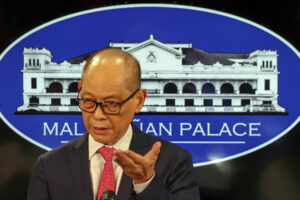




Philippines Trade Update: Trade trajectories trend along
 DOWNLOAD
DOWNLOAD

Policy Rate Updates: Double cut finale
 DOWNLOAD
DOWNLOAD

Monthly Economic Update: One for the road
 DOWNLOAD
DOWNLOAD


PH on track to hit medium-term targets — Diokno

The Philippines is on track to achieve its growth and fiscal targets in the Medium-Term Fiscal Framework (MTFF) due to the “better-than-expected” revenue and spending performance, Finance Secretary Benjamin E. Diokno said.
“Specifically, the debt-to-GDP and deficit-to-GDP ratios are likely to be less than forecasted in the MTFF,” he said in a statement on Sunday.
As of end-June, the government’s debt as a share of GDP stood at 61%, still above the 60% threshold considered by multilateral lenders to be manageable for developing economies. The government targets to end the year with a 61.2% debt-to-GDP ratio and bring it below 60% by 2025.
Meanwhile, the deficit-to-GDP ratio stood at 4.8% as of end-June. The government has set a budget deficit ceiling of PHP 1.499 trillion for 2023, equivalent to 6.1% of the GDP.
The Development Budget Coordination Committee (DBCC) said on Friday it “maintains optimism” on reaching its macroeconomic goals this year.
The DBCC held a special meeting on Friday but did not make any changes to its macroeconomic assumptions or growth targets.
The Department of Budget and Management (DBM) said that the committee is scheduled to meet within the first week of December for a final review of its macroeconomic assumptions and fiscal program this year.
The DBCC said it expects to exceed its revenue target this year. “The emerging total revenue collection for 2023 is estimated to be PHP 3.84 trillion to PHP 3.9 trillion, which is above the PHp 3.73-trillion approved DBCC level for the year,” it said.
Government revenues rose by 6.79% to PHP 2.84 trillion in the January-to-September period, surpassing by 2.98% its PHP 2.76-trillion revenue program. As of end-September, revenue collections already accounted for 76.1% of the full-year program.
Meanwhile, the DBCC said that government expenditures are expected to improve in the fourth quarter due to agencies’ accelerated spending and implementation of projects.
The National Government disbursement rate rose to 98.9% as of September from 93.4% as of June.
Data from the Treasury showed that state spending increased by an annual 4.12% to PHP 3.82 trillion in the nine-month period. However, it missed its PHP 3.86-trillion target by 1.06%.
In July, agencies have been ordered to draft catch-up plans to address low budget utilization, after a 7.1% contraction in government spending contributed to the weaker-than-expected 4.3% gross domestic product growth in the second quarter.
Meanwhile, analysts said that while current macroeconomic targets are still doable, the government may need to introduce some reforms.
“If the reforms needed to bring inflation back to (2-4%) target and if the public sector spending commitments are delivered, the goals still look viable,” BPI Lead Economist Emilio S. Neri, Jr. said in a Viber message.
Reforms that will address regulatory bottlenecks and improve ease of doing business may boost private sector confidence, he added.
Rizal Commercial Banking Corp. Chief Economist Michael L. Ricafort said that any downward revisions made would only be slight, especially on economic growth.
Economic managers are currently targeting 6-7% GDP growth for this year.
“If a revision is made, I think full-year 2023 growth at 5.8% has a higher probability than 6%,” Bienvenido S. Oplas, Jr., president of a research consultancy and of the Minimal Government Thinkers think tank, said in a Viber message.
Mr. Ricafort said economic growth will be driven by improved labor market figures, overseas Filipino worker remittances, and manufacturing data. — Luisa Maria Jacinta C. Jocson
This article originally appeared on bworldonline.com





 By BusinessWorld
By BusinessWorld